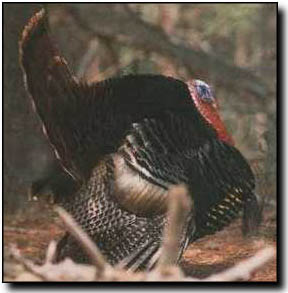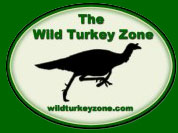| Background
 The
eastern wild turkey is the most populous of the five
distinct subspecies found in the United States and
can be found throughout the eastern United States
and has been transplanted to some western states as
well. L.J.P. Vieillot first described and named the
eastern subspecies in 1817 using the word silvestris,
meaning "forest" turkey. The
eastern wild turkey is the most populous of the five
distinct subspecies found in the United States and
can be found throughout the eastern United States
and has been transplanted to some western states as
well. L.J.P. Vieillot first described and named the
eastern subspecies in 1817 using the word silvestris,
meaning "forest" turkey.
Physical
Description
The adult male Eastern, called a
gobbler or tom, may measure up to 4 feet tall at maturity
and weigh more than 20 pounds. Easterns are the heaviest
of the 5 subspecies, and the turkeys found in the
northern parts of the U.S. can really become large.
Some of the corn fed gobblers in the upper mid-west
(Iowa, Wisconsin, Missouri) have body weights over
30 pounds. Gobbler over 25 pounds are fairly common
in those areas.
Chestnut brown-tipped tail coverts
(smaller feathers which cover up larger ones) and
dark-buff or chocolate-brown tail tips characterize
the most abundant and most widely hunted turkey, the
Eastern Wild Turkey. The gobbler’s breast feathers
are tipped in black, while other body feathers are
colored with copper or bronze metallic iridescence.
The primary wing feathers have white and black bars
that extend to the feather shaft, while the secondary
wing feathers mainly have prominent white bars. This
results in a white triangular area on each side of
the back when the wings are folded backward.
A mature female, called a hen, may
be nearly as tall but is usually lighter, weighing
between eight and twelve pounds. Females are similar
in color to the males but more brown, and the metallic
reflections are less brilliant. Feathers of the hen's
breast, flanks and sides are tipped with brown rather
than the black and white tips of the male.
Habitat
and Range
The Eastern Wild Turkey inhabits
the eastern half of the U.S., and can be found in
hardwood and mixed forests from New England and southern
Canada to northern Florida. The western boundary of
their range extends from east Texas up through eastern
Oklahoma, Kansas, and Nebraska and then on into Minnesota.
It has also been transplanted to California, Oregon,
Washington, and Ontario, Canada and other areas west
of the Rocky Mountains.
The Eastern, which has adapted to
many habitats, utilizes both hardwood and softwood
forests, open pastures, and agricultural fields.
|

